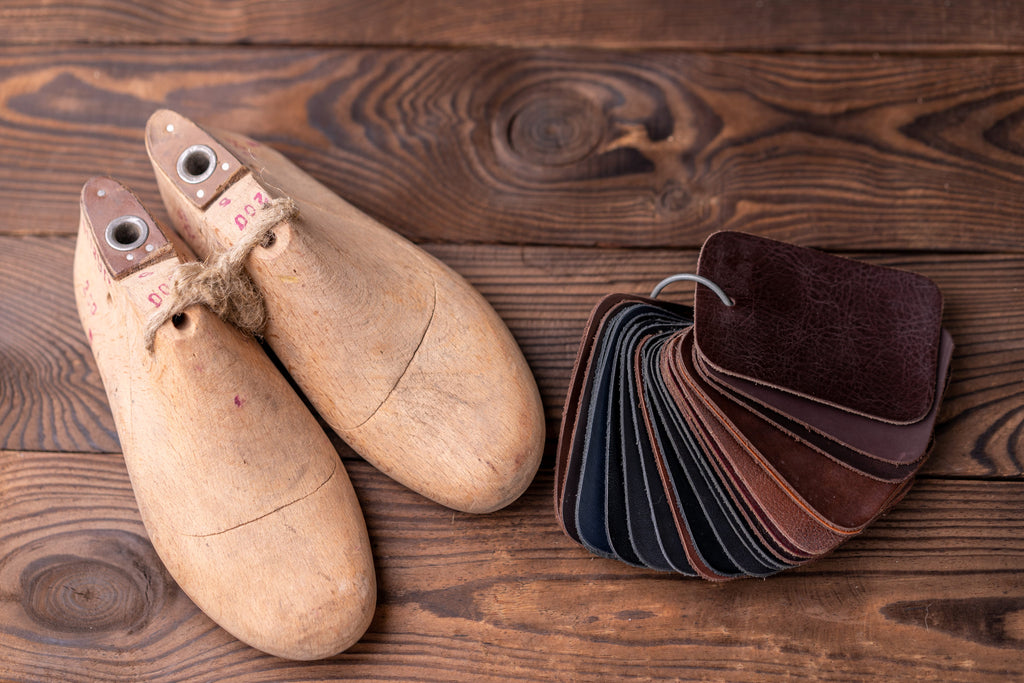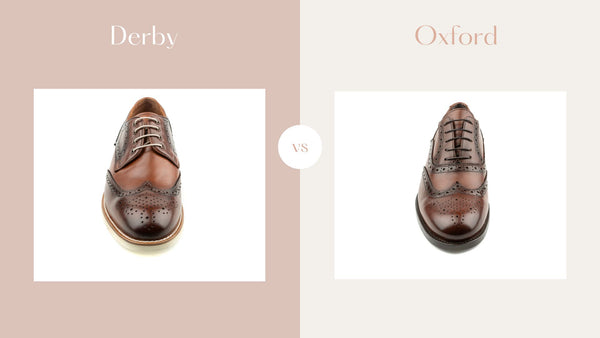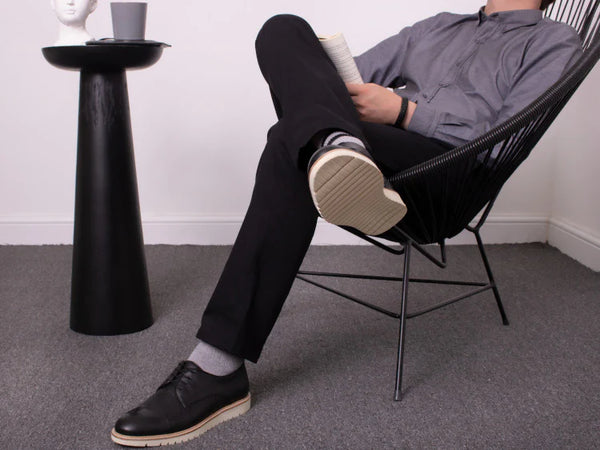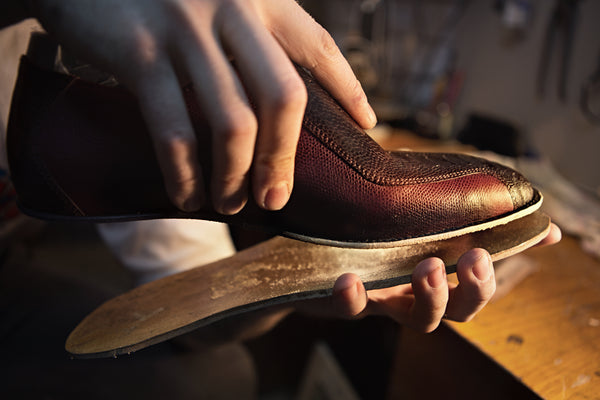20 Types of Leather for Shoes: A Comprehensive Guide For Informed Decisions
Written By ELIGIO FARINA •

- Full-Grain Leather
- Top Grain Leather
- Genuine Leather
- Suede
- Patent Leathers
- Nubuck Leather
- Shell Cordovan
- Pull-Up/Oiled Leather
- Bi-Cast Leather
- Crust Leather
- Vegan Leather
- Pigmented Leather
- Chrome-Tanned Leather
- Vegetable-Tanned Leather
- Embossed Leather
- Biodegradable Leather
- Exotic Leathers
- Aniline Leather
- Bonded Leather
- Calf Leather
While its story dates back to the genesis of mankind, as old as meeting the need for covering , leather, a hallmark of elegance, and quality and sense of manifestation is a material that transcends the boundaries of time and space. Found in the lavish interiors of sophisticated homes, draped over stylish individuals, or adorning the seats of classic automobiles, it's a testament to resilience and versatility. But it is also an indispensable material in an indispensable element of clothing which is footwear. Therefore, it is not for no reason that "types of leather for shoes" is a popular search term. Not all leathers are created equal, and the type, quality, and finish all play crucial roles in determining the longevity, comfort, and aesthetics of leather shoes.
In this comprehensive guide, we'll introduce various types of leather, with special emphasis on the "types of leather for shoes," and other striking details.
1. Full-Grain Leather: The Superior Choice Among Types of Leather for Shoes
Full-grain leather is held in high esteem in the world of men's formal footwear, renowned for its superior quality and extraordinary durability. This type of leather comes from the hide's topmost layer, keeping the natural grain intact, which gives it its name. The beauty of full-grain leather lies in its capacity to develop a rich, enhanced texture and distinct personality over time - a process known as patina. This characteristic lends an individualized touch to each pair of full-grain leather dress shoes that create a unique connection between the item and the owner. Regarded as a mark of elegance and fashion, men's dress shoes made from full-grain leather are frequently the choice of business professionals and style-conscious men. Even with its sturdy nature, full-grain leather maintains excellent breathability, offering both comfort and style. While shoes made from full-grain leather may have a higher upfront cost, their enduring appeal and longevity often make them a worthwhile investment over time. Nonetheless, it's essential to keep in mind that they require diligent care to maintain their exquisite look and ensure a prolonged lifespan.
A Perfect Example of Full Grain Leather: Debbano Koi
2. Top Grain Leather: A Favored Type of Leather for Shoes
A step down from full-grain, top-grain leather has been lightly sanded to remove imperfections, typically a few millimeters from the top, and then imprinted with an artificial grain. This makes it more pliable, easy to work with and gives shoes a more uniform appearance and it can tolerate staining much better. Although it retains many general characteristics of full grain, it is relatively slimmer, less durable, and breathable lacking the most desirable patina.
Among the other types of leather for shoes, high-end footwear designers frequently opt for top-quality leather as it offers a perfect blend of elegance, resilience, and reasonable cost.
Perfect Bleand of Resillience & Elegance: Debbano Aba Top Grain Leather Double Monks
3. Genuine Leather: The Economical Choice in Types of Leather for Shoes
Contrary to what its name implies, genuine leather is a lower-quality type of leather. Yes, it has essentially become a catchall phrase for things that are technically leather. Nonetheless, if you are looking for true leather quality, you’ll want to look at Debbano's full-grain or top-grain leather products. The quality of genuine leather is inferior to high-quality leathers such as full-grain and top-grain. It is made from scraps left over from higher grades that are stripped for more costly products. It often features an artificially embossed grain and corrected imperfections. Although visually pleasing, it lacks the robustness and longevity of its superior counterparts.
Despite its limitations, affordable footwear made from this type of leather is still a practical choice. It strikes a balance between cost and durability, making it a viable option for many consumers who want the benefits of leather shoes without breaking the bank. While it may not be as strong as full-grain or top-grain leather, it still offers a good compromise for those on a budget.
4. Suede: A Unique, Plush Type of Leather for Shoes
Suede leather, known for its distinct softness and eye-catching appeal, is a sought-after material for men's dress shoes. This type of leather is crafted by processing and buffing the hide's inner layer, resulting in a unique, velvet-like feel that sets it apart from other leathers. Men's dress shoes made from suede embody a unique blend of casual and elegant style, offering versatility for a variety of settings. The soft texture of suede lends itself to an array of vibrant colors, providing numerous options to match different ensembles and occasions. Notably, compared to full-grain leather shoes, and apparently compared to other types of leather for shoes, suede options tend to be more lightweight and breathable, making them comfortable for prolonged wear. However, suede leather shoes demand careful maintenance, as the material is more prone to staining and water damage. With the appropriate care, though, suede dress shoes can bring a sense of refined luxury and fashionable flair to any man's attire.
Suede Grace in Debbano's Syd Series
5. Patent Leather: A Glossy Beauty in Types of Leather for Shoes
Renowned for its glossy, reflective surface, patent leather is a preferred choice for crafting chic and polished shoes. This lustrous leather variety is a result of applying multiple coats of linseed oil-based lacquer to regular leather, thus elevating its aesthetics to a level of sophistication and class. An additional advantage of patent leather is its resistance to water and grime, making shoes made from it practical for wear in less-than-perfect conditions. The distinctive sheen of patent leather makes it suitable for shoes designed for formal events like black-tie affairs and weddings, and it's a frequent highlight on the men's walk of high fashion. Interestingly, despite its high-end appearance, patent leather demands low upkeep. A quick polish with a soft cloth is typically all it takes to bring back its glossy brilliance, making patent leather an attractive option for individuals who appreciate both fashion and ease of maintenance.
Patent leather is a Must Have for Black-Tie Events & Weddings, So this Splendid Palermo Style Loafer is
6. Nubuck Leather: The Soft, Durable Type of Leather for Shoes
Nubuck leather, with its delicate balance of luxury and toughness, is a highly sought-after material in the world of men's shoes. This special type of leather is produced by gently buffing the outer surface of animal hide, which yields a soft, suede-like texture, while retaining a thickness and durability that's greater than suede. This mix of softness and resilience makes nubuck an attractive choice for men's footwear in the context of types of leather for shoes. Shoes crafted from nubuck strike a perfect balance between formal and casual styles, offering flexibility for various occasions. Their high resistance to wear and tear, paired with appropriate care, ensures the shoes not only last but age beautifully over time. An interesting feature of nubuck leather is its tendency to develop a unique patina as it's worn, adding a distinctive, personal flair to each pair. However, due to its porous nature, nubuck demands a little extra upkeep to guard against stains and potential water damage.
Burgundy Nubuck Leather Derbies with Cap Toe Effect: Debbano Raj
7. Shell Cordovan: The Elite Type of Leather for Shoes
Shell Cordovan, a type of leather derived from horsehide, is regarded as an elite material in the shoemaking industry. Due to its durability and unique non-creasing characteristics, it's a coveted type of leather for high-end shoes and boots.
8. Pull-Up/Oiled Leather: A Dynamic Type of Leather for Shoes
Pull-up leather, notable for its fascinating color-changing ability when flexed or stretched, is a remarkable choice for men's dress shoes. This leather variety undergoes a tanning process that infuses it with waxes and oils, which are responsible for its unique chromatic shifts. As the leather is manipulated, the oils and waxes move, creating lighter areas that add a depth of character to the material. Men's dress shoes crafted from pull-up leather are highly regarded for their durable nature and retro appeal. The color alterations and naturally occurring wear marks that form over time make each shoe pair distinctive, mirroring the wearer's individual lifestyle. Pull-up leather's robust nature and resistance to stains and water also make it a practical choice for footwear. However, it's worth mentioning that this type of leather needs regular care with a good leather conditioner to restore the oils and waxes, thus preserving its unique features. Among types of leather for shoes Pull-up leather presents a fascinating mix of style, durability, and personalization, marking it as a standout choice in men's dress shoe selection.
9. Bi-Cast Leather: Uniform and Affordable Type of Leather for Shoes
Bi-cast leather is a type of split leather that has a synthetic layer applied to its surface, embossed to resemble a grain. This allows for a uniform look, making it a popular and affordable choice in the manufacturing of shoes, especially when cost-effectiveness is key.
10. Crust Leather: The Customizable One Among Types of Leather for Shoes
Crust leather, typically used in high-quality men's dress shoes, is a type of leather that is dyed but not fully finished. This raw state of the leather provides a unique opportunity for custom coloring and a more natural, rustic aesthetic. With its raw, unprocessed state, each piece of crust leather has a unique texture, resulting in shoes that are one-of-a-kind and richly detailed. Crust leather dress shoes, therefore, are cherished by those seeking individuality and a touch of artisanal craftsmanship in their wardrobe.
One major advantage of crust leather shoes is their ability to develop a patina over time. With proper care, they age beautifully, deepening in color and gaining character, making them a delightful long-term investment. Moreover, their unfinished nature allows for greater breathability, making them more comfortable in warmer climates. However, the unfinished nature of crust leather is also a potential disadvantage. These shoes require a bit more care and attention than their finished counterparts. They are relatively more susceptible to stains, scratches, and water damage considering other types of leather for shoes. Additionally, the color may change over time, which can be a pro or con depending on your personal style preferences. Also, crust leather shoes tend to be more expensive due to the extra hand craftsmanship involved in their creation.
11. Vegan Leather The Cruelty-Free Type of Leather for Shoes
For those with ethical considerations, vegan leather shoes offer a balance between aesthetics and principles. Made from various materials, including PVC, cork, or even fruit waste, vegan leather for shoes is aimed at mirroring the appearance and feel of real leather without using animal hides.
12. Pigmented Leather: The Color-Rich Alternative in Types of Leather for Shoes
Pigmented leather, also referred to as protected or painted leather, is typically made from top-grain leather and covered with a pigmented, opaque topcoat. Pigmented leather, lauded for its longevity and uniform coloration, is an excellent choice for crafting men's shoes. This type of leather undergoes a special treatment that adds a layer of pigment, ensuring consistent color while hiding any natural blemishes of the hide. The pigment layer also serves as a protective shield, enhancing the leather's resistance to fading, water damage, and wear and tear, which extends the shoe's life. Men's footwear fashioned from pigmented leather is known for its resilience, capable of enduring various weather conditions and daily wear, making it a sensible option for regular use. The pigmentation process also offers a broad spectrum of vivid colors, presenting a multitude of style choices to suit varying attire. In terms of care, pigmented leather shoes necessitate basic upkeep—routine cleansing with a damp cloth and periodic conditioning to maintain the leather's suppleness and prevent it from cracking. However, it's crucial to use care products specifically formulated for pigmented leather to avoid harming its protective coating. In a nutshell, pigmented types of leather for shoes marry durability, adaptability, and fashion-forward appeal, cementing their place as a dependable staple in a man's shoe wardrobe.
A High-Gloss Sample for Pigmented Leather Types for Shoes: Debbano Oro
13. Chrome-Tanned Leather: Soft and Vibrant Type of Leather for Shoes
Chrome-tanned leather makes up about 80% of all leather products, including many types of shoes. The process imbues the leather with softness and vibrant color, making it a preferred choice for everything from everyday footwear to more fashion-forward designs.
14. Vegetable-Tanned Leather: The Sturdy, Natural Type of Leather for Shoes
Valued for its environmentally considerate production method and its rich, natural look, vegetable-tanned leather is an exceptional selection for men's dress shoes. The tanning process of this leather type involves organic substances, such as tree bark and leaves, establishing it as a greener alternative to leathers treated with chemicals. This process yields a robust, high-grade leather that matures beautifully over time, acquiring a unique patina that enhances the charm of the shoes with each use. Men's dress shoes crafted from vegetable-tanned leather exude a classic sophistication, making them a perfect choice for those who value artisanal craftsmanship and environmentally friendly materials. The durabilityto of these types of leather for shoes also impresses, coping well with frequent use and, together with their appealing aging process, positions them as a valuable long-term investment. Nonetheless, it's worth mentioning that vegetable-tanned leather can be more prone to water damage and may darken under sun exposure. Regular maintenance, including shielding from weather conditions and conditioning to preserve flexibility, is key to maintaining their optimal appearance. Thus, shoes made from vegetable-tanned leather aren't merely a sartorial choice; they represent an endorsement of sustainable practices and a respect for artisan craftsmanship.
15. Embossed Leather: Distinctive Visual Appeal Among Other Types of Leather for Shoes
The distinctive and versatile embossed leather is a popular option for men's dress shoes, providing a unique blend of texture and visual depth. Embossing entails imprinting a pattern onto the leather surface, resulting in a myriad of possible designs. These could range from detailed floral or geometric patterns to imitations of exotic animal skins like crocodile or snake, thereby offering a broad spectrum of personal stylistic preferences not typically found with other leather types. One of the key advantages of embossed leather shoes is their unparalleled aesthetic allure. They have the capacity to enhance your overall ensemble, offering a focal point that not only attracts attention but also beautifully complements a meticulously tailored suit or a smart pair of casual trousers. Additionally, the textured pattern of embossed leather can often camouflage minor scratches and scuffs better than its smooth counterparts, contributing to its longevity. Moreover, embossed leather is typically lower maintenance than other leather types. The process of embossing often increases the leather's resistance to stains, while the patterned texture can conveniently hide any accumulated dirt or smudges. Thus, embossed leather is not only a visually appealing choice, but also a practical one, offering durability, ease of maintenance, and a striking design for those seeking a balance in their dress shoes.
16. Biodegradable Leather The Eco-Conscious Type of Leather for Shoes
With an increasing focus on sustainability, a new player in the "types of leather for shoes" is biodegradable leather. Made from organic materials and devoid of harmful chemicals, this type of leather decomposes over time, making it a popular choice among eco-conscious consumers.
17. Exotic Leathers: The Luxurious and Unique Type of Leather for Shoes
Exotic leathers, made from non-standard animals like snake, alligator, or ostrich, often feature unique patterns and textures. This category brings a whole new level of luxury and uniqueness to the realm of leather shoes. These leathers are not only more expensive due to their rarity, but they also require special care and maintenance.
18. Aniline Leather: The Natural Luxury Type of Leather for Shoes
Aniline leather is among the highest quality leathers you'll find in the "types of leather for shoes" category. It is a prime selection for men's dress shoes, celebrated for its natural, unaltered appearance and luxurious feel. This type of leather undergoes a dyeing process using soluble aniline dyes, which do not conceal the hide's natural markings, instead enhancing its inherent beauty and character. This results in a final product that is not only aesthetically pleasing but also incredibly soft to the touch. Dress shoes made from aniline leather exude an air of sophistication and elegance, making them an ideal choice for those seeking a refined, classic look. The natural markings and variations in the leather mean that each pair is unique, adding a personalized touch to your footwear. However, it's important to note that aniline leather is more susceptible to stains, fading, and wear due to its lack of protective coating. It requires a bit more care to keep it looking its best — regular dusting with a soft, dry cloth and occasional conditioning with a product suited for aniline leather is recommended. Avoiding exposure to direct sunlight and quickly blotting any spills can also help maintain its pristine condition. In essence, aniline leather shoes are a testament to natural beauty and luxury, making them a worthwhile addition to any discerning gentleman's wardrobe.
19. Bonded Leather The Recycled Type of Leather for Shoes
Bonded leather, often used in men's dress shoes, is an affordable alternative to full-grain leather, offering a sophisticated, high-end look without the premium price tag. Created by bonding together leftover scraps of leather, it's both eco-friendly and cost-effective, making it a popular choice for fashion-forward gentlemen. Notably, it adds a touch of class to any formal or business ensemble, making you look polished and professional. When choosing bonded leather dress shoes, consider a classic, versatile color such as black or brown. A well-crafted pair in either of these hues can complement almost any suit, from navy to grey to khaki. To prolong the life of your bonded leather shoes, apply a quality leather conditioner every few months to prevent cracking and fading. And remember, the secret to making any outfit look impeccable is the right fit. Therefore, ensure your shoes are comfortable and well-fitted, as even the most expensive shoes can look bad if they don't fit properly. With the right care and styling, bonded leather dress shoes can be an outstanding addition to your wardrobe, providing a blend of style, comfort, and durability.
20. Calf Leather: The Supple and Smooth Type of Leather for Shoes
Calf leather, derived from the hide of young cattle, is prized for its fine grain, softness, and durability. It's smoother and less prone to scratches compared to leather from mature animals, making it an excellent choice for high-end dress shoes. Shoes made from calf leather provide a level of comfort and elegance that's hard to match in the "types of leather for shoes" category.
Men's dress shoes crafted from calf leather are highly sought after and appreciated for their combination of elegance, suppleness, and resilience. This leather is sourced from the skin of young cattle, resulting in a finer grain and a softer, more pliable material than that obtained from mature cows. Its natural shine and consistent texture lend a level of sophistication to men's dress shoes that is hard to match.
A Gently Handcrafted Calfskin Loafer Featuring Buckle by Debbano: Jem
In the realm of luxury footwear, calf leather is prized not only for its aesthetic appeal but also for its practical attributes. Despite its relative softness, it's remarkably sturdy, retaining its shape well over time. Another interesting fact about calf leather is that as it ages, it doesn't just deteriorate; instead, it develops a unique patina, a soft sheen that enhances the leather's beauty.
Final Words
In closing, we've embarked on a rich and detailed exploration of the diverse types of leather for shoes. From full-grain and top-grain to patent and nubuck, each unique texture and finish serves not only a specific purpose but also caters to various styles and preferences. Understanding these differences is crucial, as the right type of leather can significantly impact the longevity, comfort, and aesthetic of your footwear. The wealth of information in this blog empowers you to make informed decisions, whether you're an avid shoe collector or simply someone who values quality and craftsmanship. Now that you're armed with this knowledge, you're ready to navigate the vast world of leather shoes with confidence and discernment. Ultimately, we hope that this blog serves as a valuable resource, helping to elevate your footwear choices and enrich your overall appreciation for the art of shoemaking.

Follow Us
Inspired by its native soil in Europe, where not only the continents but also many magnificent civilizations meet, Debbano gathers peerless sophistication, beauty, artistry, and, ultimately, the gloriousness of the best quality leather with its unique patterns and identity.
Follow us to be updated about style, colors, materials and construction techniques, fashion, lifestyle, and much more, covering the context of types of leather for shoes. You can visit our website and/or follow our Instagram and YouTube channels.












